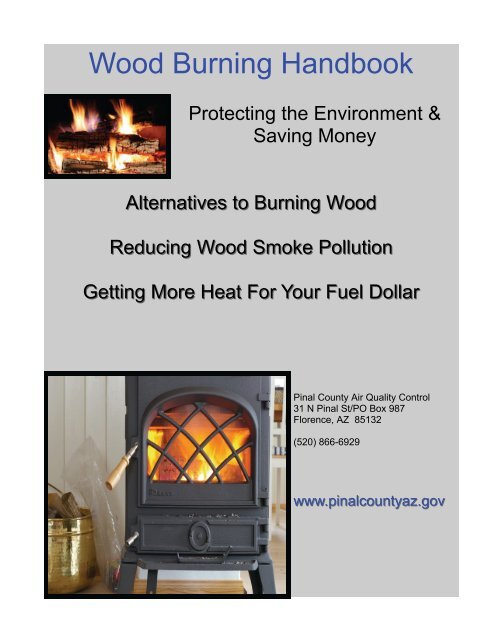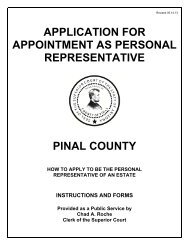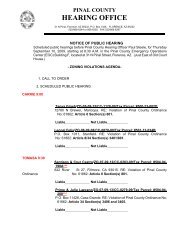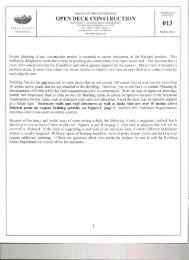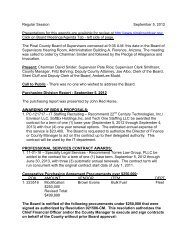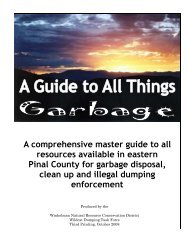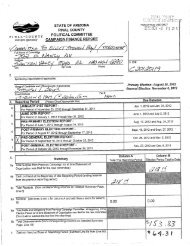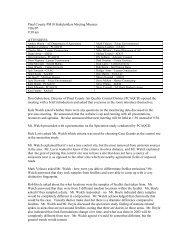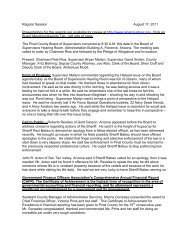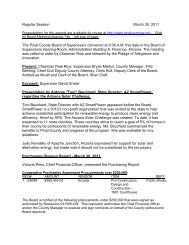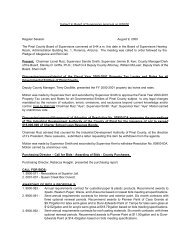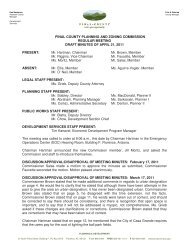Wood Burning Handbook - Pinal County
Wood Burning Handbook - Pinal County
Wood Burning Handbook - Pinal County
Create successful ePaper yourself
Turn your PDF publications into a flip-book with our unique Google optimized e-Paper software.
<strong>Wood</strong> <strong>Burning</strong> <strong>Handbook</strong><br />
Protecting the Environment &<br />
Saving Money<br />
Alternatives to <strong>Burning</strong> <strong>Wood</strong><br />
Reducing <strong>Wood</strong> Smoke Pollution<br />
Getting More Heat For Your Fuel Dollar<br />
<strong>Pinal</strong> <strong>County</strong> Air Quality Control<br />
31 N <strong>Pinal</strong> St/PO Box 987<br />
Florence, AZ 85132<br />
(520) 866-6929<br />
www.pinalcountyaz.gov
We would like to thank the<br />
California Air Resources Board<br />
for allowing <strong>Pinal</strong> <strong>County</strong> to<br />
reproduce their <strong>Wood</strong> <strong>Burning</strong> <strong>Handbook</strong><br />
including pictures, text, and illustrations.<br />
Without their approval, this handbook<br />
Cal/EPA Air Resources Board<br />
Enforcement Division<br />
Compliance Assistance Program<br />
would not be possible.<br />
http://www.arb.ca.gov/cap/cap.htm<br />
2
<strong>Burning</strong> <strong>Wood</strong> Produces <strong>Wood</strong> Smoke and Air Pollution!<br />
<strong>Pinal</strong> <strong>County</strong> Air Quality is asking you to help clear the air of wood smoke. In this handbook you will find information<br />
about the air pollutants in wood smoke, health effects of smoke, how wood burns, why it smokes<br />
and how you can reduce wood smoke pollution.<br />
Smoke from neighborhood stoves and fireplaces, a common source of both odor and reduced visibility,<br />
greatly contributes to the air pollution problems people complain about most. When you include the healthrelated<br />
problems caused by inhaling smoke pollutants, health costs for individuals and the community can<br />
be significant. To be a good neighbor, eliminate wood burning. If you do burn, learn to limit the amount of<br />
wood smoke produced.<br />
Sources of <strong>Wood</strong> <strong>Burning</strong> and Air Pollution…<br />
Air pollution affects millions of Arizonians every day. It damages<br />
our health, our crops, our property and our environment. In<br />
neighborhoods everywhere across Arizona, residential wood<br />
burning is a growing source of air pollution. Most wood heaters,<br />
such as woodstoves and fireplaces, release far more air pollution,<br />
indoors and out, than heaters using other fuels. In winter,<br />
when we heat our homes the most, cold nights with little wind<br />
cause smoke and air pollutants to remain stagnate at ground<br />
level for long periods.<br />
<strong>Burning</strong> <strong>Wood</strong> Causes Indoor Air Pollution<br />
High levels of smoke pollutants leaking from stoves and fireplaces have been<br />
measured in some wood burning homes. If you or family members suffer from<br />
chronic or repeated respiratory problems like asthma or emphysema, or have<br />
heart disease, you should not burn wood at all. If you must burn wood, make<br />
sure your stove or fireplace doesn't leak and that you operate it correctly.<br />
Remember - If you can smell smoke, you are breathing smoke!<br />
3
What Happens when <strong>Wood</strong> Burns?<br />
Complete combustion gives off light, heat, and the gases carbon dioxide and water vapor. Because<br />
when wood burns complete combustion does not occur, it also produces wood smoke, which contains<br />
the following major air pollutions, regulated by State and federal rules because of their known health effects:<br />
Carbon Monoxide (CO) – An odorless, colorless gas, produced in large<br />
amounts by burning wood with insufficient air. CO reduces the blood’s<br />
ability to supply oxygen to body tissues, and can cause stress on your<br />
heart and reduce your ability to exercise. Exposure to CO can cause longterm<br />
health problems, dizziness, confusion, severe headache, unconsciousness<br />
and even death. Those most at risk from CO poisoning are the<br />
unborn child, and people with anemia, heart, circulatory or lung disease.<br />
Oxides of Nitrogen (NOx) – NOx impairs the respiratory system and its<br />
ability to fight infection. NOx also combines with VOCs to make ozone and<br />
with water vapor to form acid rain or acid fog.<br />
Volatile Organic Compounds (VOCs) – Evaporated carbon compounds<br />
which react with NOx in sunlight to form ozone (photochemical smog).<br />
Ozone injures the lungs and makes breathing difficult, especially in children<br />
and exercising adults. NOx and VOCs also form particulate matter<br />
through reactions in the atmosphere.<br />
Toxic Pollutants - <strong>Wood</strong> smoke also contains VOCs which include toxic and/or<br />
cancer-causing substances, such as benzene, formaldehyde and benzo-apyrene,<br />
a polycyclic aromatic hydrocarbon (PAH). Manufactured fireplace logs,<br />
for instance, are not recommended for burning because they produce toxic<br />
fumes, including PCBs (polychlorinated biphenyls). Researchers are now studying<br />
these and other smoke products to learn more about their effects on human<br />
health.<br />
Particulate Matter less than 10 microns in diameter (PM10) are very small droplets of condensed<br />
organic vapors of wood tar and gases. These particles are a result of unburned fuel and have a diameter<br />
of 10 microns or smaller (the diameter of a human hair is about 50 to 100 microns), which allows<br />
them to be inhaled into the lungs. Exposure to PM10 aggravates a number of respiratory illnesses.<br />
PM10 includes a smaller group of particles called<br />
PM2.5, particles with diameters of 2.5 microns<br />
and less. These finer particles pose an increased<br />
health risk because they can lodge deep in the<br />
lungs and contain substances that are particularly<br />
harmful to human health, contributing to lung diseases<br />
and cancer. Exposure to PM2.5 may even<br />
cause early death in people with existing heart<br />
and lung disease.<br />
4
Fireplaces and Old <strong>Wood</strong>stoves Are Inefficient, Expensive<br />
Heaters!<br />
Why…Because of the Way <strong>Wood</strong> Burns -<br />
As the fire temperature rises, different stages occur:<br />
Stage 2 - Vaporizes <strong>Wood</strong> Gases<br />
Before burning, firewood "cooking" creates<br />
and releases hundreds of new volatile<br />
organic gases, which contain VOCs, tars<br />
and charcoal or carbon. Because the log<br />
temperature at this stage is too low to burn<br />
gases and tars, they escape up the flue.<br />
As they cool, some of the gases will combine<br />
with water vapor to form highly flammable<br />
creosote that sticks to the flue walls; other<br />
gases condense into smoke particles.<br />
-1000<br />
-600<br />
Stage 1 – Water Boils Off<br />
As the log heats, moisture contained in the log vaporizes,<br />
and escapes through the log's surface as water vapor.<br />
More energy is used up vaporizing the moisture<br />
than is used to burn the log. That heat energy could be<br />
warming your house instead of drying your wood before<br />
it burns.<br />
Stage 3 - Log Charcoal Burns<br />
At temperatures above 600 degrees Fahrenheit the escaping gases<br />
start burning, ignited by nearby flames. As the temperature reaches<br />
1000 degrees, the log charcoal burns and emits heat. <strong>Burning</strong> the<br />
charcoal produces most of the fire's usable heat.<br />
As you can see, most of your investment in wood goes up in smoke.<br />
This is an expensive way to produce a little heat!<br />
5
Most Fireplaces are Not Good<br />
Heaters!<br />
Most fireplaces rob your house of heat because they draw<br />
air from the room and send it up the chimney! Yes, you'll be<br />
warmed if you sit within six feet of the fire, but the rest of<br />
your house is getting colder as outdoor air leaks in to replace<br />
the hot air going up the chimney.<br />
The key to burning clean and hot is to control the airflow.<br />
Most fireplaces waste wood because of unrestricted airflow.<br />
A lot of air helps the fire burn fast, but a load of wood will<br />
last only one or two hours.<br />
Some older fireplaces actually pollute more if you install<br />
glass doors on an old fireplace insert that is not a certified<br />
clean-burning model. Restricting the air supply causes the<br />
fire to smolder and smoke. Make sure you install a new,<br />
certified clean-burning fireplace insert.<br />
Where Does Your Heat Go?<br />
Check your Insulation and Weather-Stripping<br />
Warm air is always escaping from your house, and is replaced by unheated outdoor air. The typical<br />
house has one-half to two air exchanges per hour, and more on windy and/or very cold days. If your<br />
house has little insulation and many air leaks, you are paying to heat the outdoors. And if the outside<br />
air is smoky, soon your air inside will be too.<br />
Some air exchange is necessary because of the many sources of air pollution in the home (wood heater,<br />
gas stove, consumer products, cigarettes, etc.) Sufficient fresh air inlets are needed to replace air forced<br />
out of the house by exhaust fans, dryers, furnaces, water heaters, or wood fires.<br />
Here are some suggestions to minimize excess air exchange:<br />
Install Ceiling Insulation. When hot air rises, much of the heat is lost through the ceiling and roof. Wall<br />
and floor insulation also reduce heat loss. Recommended amounts of insulation have increased in recent<br />
years, so be sure your house has all it needs.<br />
Caulk around all windows, doors, pipes, and any opening into the<br />
house.<br />
Weather-strip all door and window openings. Consider installing<br />
double-paned glass, outdoor or indoor storm windows, and/or insulated<br />
curtains.<br />
Close the damper tightly when the heater is not in use. Stoves<br />
and fireplaces allow air to leak out of the house even when they are<br />
not operating, unless they are literally airtight.<br />
Close off unused rooms if you do not use central heating –<br />
Don’t waste the heat!<br />
6
Clean up your Air Guzzling Fireplace by Trying Alternate<br />
Heating Methods…<br />
Use an Electric Fireplace<br />
Electric fireplaces can be installed anywhere, and<br />
no vent is required. They can be plugged into any<br />
standard household electrical (120V) outlet and<br />
can operate with or without heat. Most fireplaces<br />
are made with an adjustable thermostat that maintains<br />
room temperatures. The fireplace glass does not<br />
absorb heat, so is safe to touch whether or not<br />
the heater is operating.<br />
Switch to Gas<br />
Try a Pellet Stove<br />
Gas fireplaces are very popular and look like a real wood fire! They are<br />
self-contained units, which can be fitted into your existing (vented) fireplace.<br />
They send less of your heated air up the chimney. This equipment<br />
burns cleaner, is easy to start, convenient, safe and inexpensive to operate,<br />
and is a good source of heat. Gas fireplaces are also a good choice if<br />
you’re remodeling a home and replacing a wood fireplace.<br />
Pellet stoves are the most efficient and least polluting of the new stove<br />
designs. Most are exempt from certification because they provide less<br />
than 1 gram per hour of particulate emissions. Usually these stoves have<br />
some moving parts and require electricity. The fuel, which is made from<br />
compressed wood waste and formed into pellets, automatically feeds into<br />
the firebox. Combustion air is drawn in and the fire burns hot and clean.<br />
Another fan blows room air through a heat exchanger and into the room.<br />
Install a Certified <strong>Wood</strong> <strong>Burning</strong> Fireplace Insert<br />
Fireplace inserts have been developed which meet federal emission standards<br />
and provide high fuel efficiency. They are available in many sizes<br />
and styles to fit into your masonry fireplace. They provide excellent fire<br />
viewing and heat output with very little smoke.<br />
7
U.S. EPA Certified <strong>Wood</strong> Stoves<br />
U.S. EPA Certified <strong>Wood</strong> Stoves Heat More and Pollute Less<br />
U.S. EPA requires wood stove manufacturers to conduct a quality assurance program for wood heaters.<br />
<strong>Wood</strong> heaters must be certified. A permanent label on a wood heater indicates that it meets the emission<br />
standards. A consumer information label is also required that specifies the emission rate, the heating range<br />
of the wood heater, and overall efficiency. Certified stoves heat better with less wood because they burn<br />
more of the combustible gases that would otherwise become smoke in fireplaces and old stoves. There are<br />
two types of certified wood stove designs to choose from:<br />
Catalytic Stoves<br />
Similar to the smog control device on new cars, the catalytic combustor in<br />
these stoves allows the volatile gases to burn at lower temperatures. Smoke<br />
passes through a ceramic honeycomb coated with a rare-metal catalyst,<br />
which allows complete smoke combustion and heat release at only 500-700<br />
degrees F. Their efficiency does drop over time and the catalyst device requires<br />
replacement after three to seven years of use.<br />
Non-Catalytic Stoves<br />
These stoves are designed with baffles and/or secondary combustion chambers,<br />
which route the burnable gases through the hottest part of the firebox and mix<br />
them with sufficient air to burn them more completely. They can attain up to four<br />
stages of combustion and completely burn the wood smoke before it escapes.<br />
If your woodstove is not U.S.EPA certified, you should consider buying a new certified woodstove. A new<br />
U.S. EPA certified stove will increase combustion efficiency, produce far less smoke and creosote buildup,<br />
and reduce air pollution. It uses the latest and best technology available on transfer efficiency, and will provide<br />
more heat for your house and less for your flue. If you want to pollute less and save money on fuel, you<br />
should insist on an EPA Certified device, which will be clearly labeled as such.<br />
For a list of U.S. EPA certified stoves see:<br />
http://www.epa.gov/Compliance/resources/publications/monitoring/caa/woodstoves/<br />
certifiedwood.pdf<br />
8
U.S. EPA Certified <strong>Wood</strong> Stoves Release Fewer Particulate<br />
Emissions<br />
Because of incomplete combustion, old wood stoves can<br />
produce up to 50 grams of particulate per hour. EPA Certified<br />
fireplace inserts and EPA Certified wood stoves are<br />
considerably more efficient, producing only 6 grams per<br />
hour. EPA Certified devices create the right conditions for<br />
complete combustion; the right amount of air, high temperature,<br />
and time to allow the gases to fully burn.<br />
Check How Much Heat You Get …<br />
The heating efficiency of any wood heater depends on combining<br />
two factors:<br />
• How completely it burns the firewood<br />
(combustion efficiency), and<br />
How much of the fire's heat gets into the room, rather<br />
than going up the flue (transfer efficiency).<br />
How efficiently your wood heater operates depends on 2<br />
more factors:<br />
Installation – is it located on an outside wall? Too big<br />
for house? Flue draws well?<br />
Operation – Is the wood green? Is the stove stuffed<br />
with wood? Is the fire starved for air?<br />
Your operating techniques account for the<br />
largest variations in your woodstove's<br />
heating efficiency.<br />
Particulate:<br />
50 grams<br />
in 1 hour<br />
Non-Certified Stove - U.S.EPA Certified Stove<br />
Heating Efficiency<br />
Look for the Permanent U.S. EPA Label on Certified Devices!<br />
For maximum safety and efficiency have a professional installer<br />
calculate the correct stove size for the area, install the<br />
stove, and design and install the chimney.<br />
6 grams in<br />
1 hour<br />
Masonry Fireplace -10% to 10%<br />
Manufactured Fireplace -10% to 10%<br />
Freestanding Fireplace -10% to 30%<br />
Antique Stove 20% to 40%<br />
Fireplace Insert 35% to 50%<br />
Airtight Stove 40% to 50%<br />
Certified Stoves, 60% to 80%<br />
Inserts, Fireplaces<br />
Gas Heater 60% to 90%<br />
Pellet Stove 75% to 90%<br />
Electric Fireplace 100%<br />
9
If you Still Must Burn <strong>Wood</strong>, Follow These Tips on<br />
Clean <strong>Burning</strong> – To Heat More Efficiently and Reduce<br />
Air Pollution!<br />
Start Your Fire With Softwood Kindling<br />
Softwoods (pine, fir) are generally low in density,<br />
ignite easily, burn fast and hot and will heat the<br />
firebox and flue quickly. They are ideal for kindling<br />
and starting your fires, but form creosote easily<br />
due to the high resin (sap) content.<br />
Burn Longer and Cleaner With Hardwood<br />
Hardwoods (oak, cherry) are denser and take<br />
longer to ignite, but burn slower and more evenly,<br />
producing less smoke. They also provide more<br />
heat energy than softwood logs of the same size.<br />
Burn Only "Seasoned" Firewood<br />
Firewood should dry, or "season" a minimum of 6 to 12 months after splitting.<br />
Hardwoods dry more slowly than softwoods and may take over a year to dry. Seasoned<br />
firewood by definition contains 20 percent moisture or less by weight. <strong>Wood</strong><br />
dries faster in a warmer storage area with more air circulation.<br />
To Speed Drying:<br />
Split and Stack— logs dry from the Store High & Dry—Stack a foot or more<br />
outside in, so split big logs right away above the ground and away from buildings<br />
for faster drying. Stack loosely in a in a sunny, well-ventilated area. Cover the top<br />
crosswise fashion to get good air to keep dew and rain off the wood, but leave<br />
circulation. the sides open to breezes.<br />
10
Be Careful when Buying <strong>Wood</strong> Advertised as "Seasoned". Look for:<br />
Dark colored, cracked ends, with cracks radiating from the center like<br />
bicycle spokes.<br />
Light in weight, meaning there is little moisture left; hardwood logs will<br />
weigh more than softwood.<br />
Sound - Hit two pieces together. Wet wood makes<br />
a dull "thud" sound. Dry wood rings with a resonant<br />
"crack," like a bat hitting a baseball.<br />
Easily peeled or broken bark. No green should<br />
show under the bark.<br />
Build a Small, HOT Fire First…<br />
Refuel While the Coals Are Still Hot!<br />
Open Damper Wide - allow in maximum air to fuel the fire. And leave it and<br />
other air inlets open for 30 minutes.<br />
Start Small and Hot - leave a thin layer of ash for insulation. Crumple a few<br />
sheets of newspaper and add some small pieces of kindling, then light. Add<br />
bigger kindling a few at a time as the fire grows. Get it burning briskly to form<br />
a bed of hot coals. Now add 2 or 3 logs.<br />
Position the next logs carefully - place logs close enough together to keep<br />
each other hot, but far apart enough to let sufficient air (oxygen) move<br />
between them.<br />
If a fireplace insert or glass door is present, open it slightly for a minute to<br />
prevent back puffing of smoke into the room. When smoke subsides, then<br />
open the door fully.<br />
Preheat again by placing a few pieces of kindling onto the red-hot coals. Add<br />
more as they catch fire, then add a few larger pieces. Small, frequent<br />
loading causes less smoke than a big load in most older stoves.<br />
After refueling, leave the dampers and inlets open for about 30 minutes. The<br />
fire will get plenty of air and burn hot, retarding creosote formation (which forms early in a burn).<br />
Light & Refuel your fire quickly and carefully.<br />
These are the times it will smoke the most.<br />
11
Don’t Burn Anything but Clean, Seasoned<br />
<strong>Wood</strong>, Fireplace Logs, and Non-glossy White Paper<br />
- No Garbage - No Plastics<br />
- No Rubber - No Waste<br />
- No Particleboard - No Plywood<br />
- No Glossy Paper - No Colored Paper<br />
- No Solvent or Paint - No Oil<br />
- No Coal or Charcoal - No Painted/ Treated <strong>Wood</strong><br />
<strong>Burning</strong> these materials can produce noxious, corrosive smoke and<br />
fumes that may be toxic. They can foul your catalytic combustor, your<br />
flue, and the lungs of your family and neighbors.<br />
Heating in Warmer Weather<br />
Warning: Kiln-Dried Lumber vaporizes too<br />
rapidly, causing creosote buildup.<br />
If you do need extra heat in warmer weather,<br />
and a small space heater will not suffice, open the<br />
air controls wide, build a small, hot fire, using<br />
more finely split wood, and let it burn out.<br />
DO NOT try to reduce the heat from a big fire by<br />
reducing its air supply because this leads to<br />
smoldering, creosote buildup and air pollution.<br />
Overnight Heating<br />
When using an open fireplace, DO NOT<br />
burn overnight unattended - it's a major fire<br />
hazard. This can also lead to a back draft of<br />
the smoke into your own home, causing very<br />
hazardous indoor air pollution.<br />
Build a small, hot fire and let it burn out completely.<br />
Rely on your home's insulation to<br />
hold in enough heat for the night. When the<br />
fire is out, close the damper tightly.<br />
12
Maintain Your Fire Properly –<br />
Watch the Temperature<br />
Do Not Close the Damper or Air Inlets Too Tightly - The fire will smoke from lack of air.<br />
Follow the <strong>Wood</strong> Stove or Fireplace Manufacturer's Instructions Carefully - Be sure that<br />
anyone who operates it is also familiar with these instructions.<br />
Your Actions Determine How Efficiently Your Fireplace or <strong>Wood</strong> Stove Will Operate - A<br />
good wood stove/fireplace is designed to burn cleanly and efficiently, but it can not do its<br />
job right if you do not cooperate.<br />
Watch for Smoke Signals!<br />
Get into the habit of glancing out at your chimney top every<br />
so often. Apart from the half hour after lighting and refueling,<br />
a properly burning fire should give off only a thin wisp of white<br />
steam. If you see smoke, adjust your dampers or air inlets to<br />
let in more air. The darker the smoke, the more pollutants it<br />
contains and the more fuel is being wasted.<br />
Inspection and Upkeep - For Safety’s Sake<br />
Periodic inspection of your wood stove or fireplace is essential to<br />
ensuring its continued safe and clean-burning operation. Keep in<br />
mind the following points when performing your fireplace inspection:<br />
<br />
<br />
Chimney Caps can be plugged by<br />
debris, which will reduce draft.<br />
Chimneys should be cleaned professionally at least once a year to remove<br />
creosote buildup. Remember – Creosote can fuel a chimney fire<br />
that can burn down your house!<br />
Catalytic Combustor holes can plug up; follow instructions to clean.<br />
Stovepipe angles and bolts are particularly subject to corrosion.<br />
Gaskets on airtight stove doors need replacement every few years.<br />
Seams on stoves sealed with furnace cement may leak. Eventually the cement dries out, becomes<br />
brittle, and may fall out.<br />
Firebricks may be broken or missing.<br />
Grates or stove bottoms can crack or break.<br />
13
CHOOSE NOT TO BURN WHEN AIR QUALITY IS ALREADY POOR!<br />
For more information contact <strong>Pinal</strong> <strong>County</strong> Building Safety,<br />
your fire department, county agricultural extension office,<br />
woodstove retailer, chimneysweep, or <strong>Pinal</strong> <strong>County</strong> Air<br />
Quality Control District.<br />
Arizona and <strong>Pinal</strong> <strong>County</strong> Air Quality urge you to burn clean,<br />
burn safe, and burn smart.<br />
14


